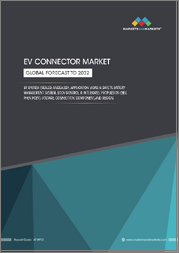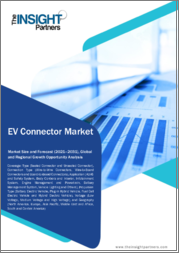
|
시장보고서
상품코드
1419600
세계 전기 자동차용 커넥터 시장 : 커넥터 유형별, 전류 유형별, 충전 속도별, 설치 유형별, 최종 사용자별, 지역별, 기회 및 예측(2017년-2031년)Electric Vehicle Connector Market Assessment, By Connector Type, By Current Type, By Charging Speed, By Mounting Type, By End-user, By Region, Opportunities and Forecast, 2017-2031F |
||||||
세계 전기 자동차용 커넥터 시장 규모는 2023년에 7,548만 달러를 나타냈고 2031년에 3억 2,563만 달러에 이를 전망이며 2024년부터 2031년까지 복합 연간 성장률(CAGR) 20.05%의 성장이 전망되고 있습니다. 세계 전기 자동차용 커넥터 시장은 세계 전기 자동차 채택의 확대로 급성장을 보여줍니다. 지속가능한 수송으로의 전환과 청정에너지를 추진하는 정부의 이니셔티브는 전기자동차 수요를 촉진하고 전기자동차용 커넥터 시장을 뒷받침하고 있습니다. 엄격한 배기 가스 규제와 소비자의 환경 의식 증가는이 시장을 발전시키는 중요한 요소입니다. 자동차 제조업체가 전동 이동성에 많은 투자를 계속하고 있는 가운데, 신뢰성이 높고 효율적인 충전 인프라의 필요성이 가장 중요해져, 선진의 EV용 커넥터 수요를 촉진하고 있습니다. EV 커넥터 시장의 혁신은 충전 솔루션 가속화, 안전 기능 강화, 서로 다른 충전 표준 간의 호환성에 주목하는 특징입니다.
단시간에 대량의 에너지를 공급할 수 있는 초급속 충전기와 같은 고출력 충전 기술의 등장은 EV 사용자에게 중요한 관심사인 충전 시간을 다루는 것입니다. 또한 스마트 충전 및 무선 충전 기술이 각광받고 사용자에게 보다 편리함을 제공합니다. 첨단 소재 통합 및 설계 강화는 커넥터의 내구성과 효율성 향상을 목표로 합니다. 자동차 제조업체와 충전 인프라 제공업체의 협력을 통해 상호 운용성을 촉진하고 세계 전기 자동차 사용자에게 원활한 충전 경험을 제공합니다. 전반적으로 전기 자동차용 커넥터 시장은 급성장하는 전동 이동성 부문의 진화하는 요구에 대응하기 때문에 급속히 진화하고 있습니다. 예를 들어, Starbucks는 Volvo와 제휴하여 콜로라도, 유타, 아이다호, 오레곤, 덴버에서 시애틀까지의 Starbucks15 상점에 50개의 DC 급속 충전소을 개설했습니다. 이 충전소은 Volvo의 C40 Recharge를 포함한 CCS1 또는 CHAdeMO 커넥터가 있는 전기 자동차를 충전할 수 있습니다.
충전 네트워크에 대한 투자 증가
세계 전기 자동차용 커넥터 시장은 주요 기업들이 충전 네트워크에 대한 투자 증가로 상당한 고조를 보이고 있습니다. 전기 이동성 추진에서 충전 인프라의 중요한 역할을 인정하고, 테슬라와 같은 주요 기업 및 충전 네트워크 사업자는 충전 네트워크의 확대와 강화에 많은 자원을 나누고 있습니다. 이러한 전략적 투자는 항속거리의 불안에 대처하고 EV의 보급을 촉진하기 위해 충전소, 특히 급속 충전소을 더 전개하는 것에 중점을 둡니다. 자동차 제조업체와 충전 인프라 제공업체의 제휴는 상호 운용성과 원활한 충전 경험을 촉진하여 이러한 동향을 더욱 가속화하고 있습니다. 종합적인 충전 네트워크 구축에 대한이 견고한 헌신은 세계 전기 자동차의 성장과 접근성을 지원하는 주요 기업의 기여를 보여줍니다.
전기 자동차 커넥터의 기술 발전
지속적인 혁신이 주요 과제를 해결하고 전반적인 효율성을 높이기 때문에 기술 발전이 시장을 진전시킵니다. 재료와 설계의 진보는 보다 내구성과 내열성 커넥터의 개발에 기여하고 있습니다. 고출력 충전 기술은 빠르게 진화하고 있으며 충전 시간을 단축할 수 있어 EV 사용자의 심각한 우려를 해결하고 있습니다. 통신 프로토콜 및 무선 연결과 같은 스마트 기능의 통합은 사용자 경험을 향상시키고 충전 인프라와의 원활한 상호작용을 가능하게 합니다. 또한, 진행 중인 R&D는 다양한 충전 표준과 호환되는 커넥터의 생성을 강조하여 상호 운용성과 유연성을 촉진합니다. 예를 들어, SEVD(TM)-V3은 V2X(Vehicle-to-Everything) 용도용으로 특별히 설계된 EV DC 충전기/방전기용 커넥터가 있는 케이블입니다. EV 및 V2H(Vehicle-to-Home) 용도용 DC 급속 충전기의 주요 부분인 V2X 커넥터입니다. SEVD(TM)-V3은 작고 가볍고 안전한 EV용 커넥터 케이블 어셈블리로 효율적이고 안전한 충전 솔루션을 실현하는 데 기여하고자 합니다.
이 보고서는 세계 전기 자동차용 커넥터 시장에 대한 조사 분석을 통해 시장 규모와 예측, 시장 역학, 주요 기업 상황과 전망 등의 정보를 제공합니다.
목차
제1장 조사 방법
제2장 프로젝트의 범위와 정의
제3장 주요 요약
제4장 고객의 목소리
- 품질, 성능
- 지속가능성과 환경에 미치는 영향
- 비용
- 규제 당국의 승인과 안전성
- 혁신
- 용도와의 적합성
- 항속 거리, 배터리 기술
- 공급망, 가용성
- 브랜드 평판, 신뢰
- 애프터 서비스, 서포트
제5장 세계 전기 자동차용 커넥터 시장 전망(2017년-2031년)
- 시장 규모와 예측
- 금액
- 수량
- 커넥터 유형별
- Type 1
- CCS
- Chademo
- 기타
- 전류 유형별
- 교류
- 직류
- 충전 속도별
- 저속
- 고속
- 급속
- 설치 유형별
- 마루 두어형
- 벽걸이형
- 최종 사용자별
- 주택
- 상업
- 지역별
- 북미
- 유럽
- 남미
- 아시아태평양
- 중동 및 아프리카
- 시장 점유율 : 기업별(2023년)
제6장 세계 전기 자동차용 커넥터 시장 전망: 지역별(2017년-2031년)
- 북미
- 시장 규모와 예측
- 커넥터 유형별
- 전류 유형별
- 충전 속도별
- 설치 유형별
- 최종 사용자별
- 미국
- 캐나다
- 멕시코
- 유럽
- 독일
- 프랑스
- 이탈리아
- 영국
- 러시아
- 네덜란드
- 스페인
- 남미
- 브라질
- 아르헨티나
- 아시아태평양
- 인도
- 중국
- 일본
- 호주
- 한국
- 중동 및 아프리카
- 사우디아라비아
- 아랍에미리트(UAE)
- 남아프리카
제7장 시장 매핑(2023년)
- 커넥터 유형별
- 전류 유형별
- 충전 속도별
- 설치 유형별
- 최종 사용자별
- 지역별
제8장 거시적 환경과 산업 구조
- 수급 분석
- 수출입 분석
- 밸류체인 분석
- PESTEL 분석
- Porter's Five Forces 분석
제9장 시장 역학
- 성장 촉진요인
- 성장 억제요인(과제, 성장 억제요인)
제10장 주요 기업 정세
- 마켓 리더 상위 5개사의 경쟁 매트릭스
- 마켓 리더 상위 5개사 시장 수익 분석(2023년)
- 합병과 인수/합작사업(해당하는 경우)
- SWOT 분석(시장 참가 기업 5사)
- 특허 분석(해당하는 경우)
제11장 가격 분석
제12장 사례 연구
제13장 주요 기업의 전망
- Aptiv PLC
- Fujikura Ltd.
- Tyco Electronics Ltd.
- Sumitomo Electric Industries Ltd.
- HUBER SUHNER Electronics Private Limited.
- Tesla, Inc.
- Siemens AG
- Besen International Group Co., Ltd.
- Harting Stiftung & Co. KG
- Weidmuller Interface GmbH & Co. KG.
제14장 전략적 권장사항
제15장 당사에 대하여 면책사항
BJH 24.02.15Global electric vehicle connector market size was valued at USD 75.48 million in 2023, expected to reach USD 325.63 million in 2031, with a CAGR of 20.05% for the forecast period between 2024 and 2031. The global electric vehicle connector market is experiencing a significant surge, driven by the increasing adoption of electric vehicles worldwide. The transition towards sustainable transportation and government initiatives promoting clean energy has fueled the demand for EVs, subsequently boosting the market for electric vehicle connectors. Stringent emissions regulations and a growing consumer environmental consciousness are pivotal factors propelling this market forward. As automakers continue to invest heavily in electric mobility, the need for reliable and efficient charging infrastructure becomes paramount, driving the demand for advanced EV connectors. Innovations in the EV connector market is marked by a focus on faster charging solutions, enhanced safety features, and compatibility across different charging standards.
The advent of high-power charging technologies, such as ultra-fast chargers capable of delivering substantial energy in a shorter time frame, addresses a key concern for EV users - charging time. Furthermore, smart, and wireless charging technologies are gaining prominence, providing added convenience to users. The integration of advanced materials and design enhancements aims to make connectors more durable and efficient. Collaborations between automakers and charging infrastructure providers are fostering interoperability, ensuring a seamless charging experience for EV users globally. Overall, the electric vehicle connector market is evolving rapidly to meet the evolving needs of the burgeoning electric mobility sector. For example, Starbucks has partnered with Volvo to open 50 DC fast charging stations at 15 Starbucks stores in Colorado, Utah, Idaho, Oregon, route from Denver to Seattle. The charging stations can recharge any electric car with a CCS1 or CHAdeMO connector, including Volvo's C40 Recharge.
Increasing Investment in Charging Network
The global electric vehicle connector market is witnessing a substantial boost due to the increasing investment in charging networks by key players. Recognizing the pivotal role of charging infrastructure in promoting electric mobility, major companies such as Tesla and charging network operators are allocating significant resources to expand and enhance charging networks. These strategic investments focus on deploying more charging stations, especially fast-charging ones, to address range anxiety and encourage widespread EV adoption. Collaborations between automakers and charging infrastructure providers further amplify this trend, fostering interoperability and a seamless charging experience. This robust commitment to building a comprehensive charging network underscores the key players' dedication to supporting the growth and accessibility of electric vehicles globally.
Technological Advancements in Electric Vehicle Connector
Technological advancements propel the market forward, as continuous innovation addresses key challenges and enhances overall efficiency. Advancements in materials and design contribute to the development of more durable and heat-resistant connectors. High-power charging technologies are evolving rapidly, enabling faster charging times, and addressing a critical concern for EV users. The integration of smart features, such as communication protocols and wireless connectivity, enhances user experience and enables seamless interactions with charging infrastructure. Moreover, ongoing research and development focus on creating connectors compatible with various charging standards, promoting interoperability and flexibility. For example, The SEVD™-V3 is a cable with a connector for EV DC charger/discharger, specifically designed for V2X (Vehicle-to-Everything) applications. It is a V2X connector that is the main part of the DC quick charger for EVs and vehicle-to-home (V2H) applications. The SEVD™-V3 is a compact, lightweight, and safe connector cable assembly for EVs, aiming to contribute to the realization of efficient and secure charging solutions.
Shift Towards DC Fast Charging Points
The market is witnessing a significant shift towards DC fast charging points, reflecting the industry's commitment to address range anxiety and enhance the charging experience. DC fast charging technology allows for rapid charging, significantly reducing the time required to recharge EV batteries. This shift is crucial in supporting long-distance travel and accommodating the growing number of electric vehicles on the roads. Key players in the EV connector market are actively investing in the development and deployment of DC fast charging infrastructure, aligning with the evolving needs of electric mobility. This transition underscores a strategic focus on enhancing convenience and accessibility and encouraging the widespread adoption of electric vehicles across the globe.
For example, Fujikura Components Ltd. offers a CCS Type2 connector that is lightweight, compact, and has a robust structure. The connector is stylishly designed and conforms to IEC62196-3 standards. The CCS Type2 connector complies with IEC62196-3 Config FF, weighs 1.1kg, and is tough. The connector is suitable for DC charging and can be used for fast charging of electric vehicles.
Government Regulations
Government regulations are pivotal in shaping the global electric vehicle connector market. Various countries are implementing stringent emission standards and providing financial incentives to promote the adoption of electric vehicles, driving the demand for EV connectors. Regulatory initiatives often include mandates for developing public charging infrastructure, influencing connector standards. Incentives such as tax credits, rebates, and subsidies for EV purchases create a favorable environment for consumers, stimulating market growth. Additionally, some regions are actively working on establishing standardized norms for connector design and safety features to ensure uniformity across the EV charging ecosystem. These evolving regulations underscore the commitment to sustainable transportation and significantly impact the dynamics of the global EV connector market.
For example, The Bureau of Indian Standards (BIS), India's National Standard Body, has approved the country's first indigenous AC and DC Combined Charging connector standard for light electric vehicles (LEVs). This standard, known as IS17017 (Part 2 / Sec 7): 2023, is the world's first combined AC and DC charging connector standard for LEVs. This innovation, developed in India, has the potential to set a global benchmark for the LEV industry.
Key Player Landscape and Outlook
The global electric vehicle connector market is characterized by the presence of key players driving innovation and market expansion. Leading companies such as Tesla and Siemens play pivotal roles, contributing to the development and deployment of advanced EV charging solutions. These companies focus on research and development to enhance connector technology, aiming for faster charging, improved safety, and compatibility across diverse charging standards. As the EV market continues to grow, collaborations and partnerships among key players become crucial for the establishment of a robust charging infrastructure. The outlook for the global EV connector market remains promising, with an increasing emphasis on interoperability, smart charging solutions, and sustainability in the evolving landscape of electric mobility.
For instance, in November 2022, Tesla made its EV charging connector design available to other automakers and network operators in North America to encourage adoption of the technology and make it the new standard. The charging connector in all Tesla vehicles offers AC charging and up to 1 MW DC charging, and its compact design and performance are considered superior to the Combined Charging System (CCS) connectors used by most EVs in North America. Tesla's design and specification files are available for download, and the company is actively working with relevant standards bodies to collect Tesla's charging connector as the North American Charging Standard (NACS).
For instance, in June 2022, Siemens invested USD 25 million to acquire a minority stake in WiTricity, a United States-based wireless charging technology company. The two companies aim to drive innovation in the wireless EV charging market, which is projected to reach USD 2 billion by 2028 in Europe and North America. They seek to address global standardization gaps, enable interoperability between vehicles and infrastructure, and advance the technical development of wireless charging systems.
Table of Contents
1. Research Methodology
2. Project Scope & Definitions
3. Executive Summary
4. Voice of Customer
- 4.1. Quality and Performance
- 4.2. Sustainability and Environmental Impact
- 4.3. Cost
- 4.4. Regulatory Approval and Safety
- 4.5. Innovation
- 4.6. Compatibility with Applications
- 4.7. Range and Battery Technology
- 4.8. Supply Chain and Availability
- 4.9. Brand Reputation and Trust
- 4.10. After-Sales Services and Support
5. Global Electric Vehicle Connector Market Outlook, 2017-2031F
- 5.1. Market Size & Forecast
- 5.1.1. By Value
- 5.1.2. By Volume
- 5.2. By Connector Type
- 5.2.1. Type 1
- 5.2.2. CCS
- 5.2.3. Chademo
- 5.2.4. Others
- 5.3. By Current Type
- 5.3.1. Alternate Current
- 5.3.2. Direct Current
- 5.4. By Charging Speed
- 5.4.1. Slow
- 5.4.2. Fast
- 5.4.3. Rapid
- 5.5. By Mounting Type
- 5.5.1. Floor Mounted
- 5.5.2. Wall Mounted
- 5.6. By End-user
- 5.6.1. Residential
- 5.6.2. Commercial
- 5.7. By Region
- 5.7.1. North America
- 5.7.2. Europe
- 5.7.3. South America
- 5.7.4. Asia-Pacific
- 5.7.5. Middle East and Africa
- 5.8. By Company Market Share (%), 2023
6. Global Electric Vehicle Connector Market Outlook, By Region, 2017-2031F
- 6.1. North America*
- 6.1.1. Market Size & Forecast
- 6.1.1.1. By Value
- 6.1.1.2. By Volume
- 6.1.2. By Connector Type
- 6.1.2.1. Type 1
- 6.1.2.2. CCS
- 6.1.2.3. Chademo
- 6.1.2.4. Others
- 6.1.3. By Current Type
- 6.1.3.1. Alternate Current
- 6.1.3.2. Direct Current
- 6.1.4. By Charging Speed
- 6.1.4.1. Slow
- 6.1.4.2. Fast
- 6.1.4.3. Rapid
- 6.1.5. By Mounting Type
- 6.1.5.1. Floor Mounted
- 6.1.5.2. Wall Mounted
- 6.1.6. By End-user
- 6.1.6.1. Residential
- 6.1.6.2. Commercial
- 6.1.7. United States*
- 6.1.7.1. Market Size & Forecast
- 6.1.7.1.1. By Value
- 6.1.7.1.2. By Volume
- 6.1.7.2. By Connector Type
- 6.1.7.2.1. Type 1
- 6.1.7.2.2. CCS
- 6.1.7.2.3. Chademo
- 6.1.7.2.4. Others
- 6.1.7.3. By Current Type
- 6.1.7.3.1. Alternate Current
- 6.1.7.3.2. Direct Current
- 6.1.7.4. By Charging Speed
- 6.1.7.4.1. Slow
- 6.1.7.4.2. Fast
- 6.1.7.4.3. Rapid
- 6.1.7.5. By Mounting Type
- 6.1.7.5.1. Floor Mounted
- 6.1.7.5.2. Wall Mounted
- 6.1.7.6. By End-user
- 6.1.7.6.1. Residential
- 6.1.7.6.2. Commercial
- 6.1.8. Canada
- 6.1.9. Mexico
- 6.1.1. Market Size & Forecast
All segments will be provided for all regions and countries covered:
- 6.2. Europe
- 6.2.1. Germany
- 6.2.2. France
- 6.2.3. Italy
- 6.2.4. United Kingdom
- 6.2.5. Russia
- 6.2.6. Netherlands
- 6.2.7. Spain
- 6.3. South America
- 6.3.1. Brazil
- 6.3.2. Argentina
- 6.4. Asia-Pacific
- 6.4.1. India
- 6.4.2. China
- 6.4.3. Japan
- 6.4.4. Australia
- 6.4.5. South Korea
- 6.5. Middle East & Africa
- 6.5.1. Saudi Arabia
- 6.5.2. UAE
- 6.5.3. South Africa
7. Market Mapping, 2023
- 7.1. By Connector Type
- 7.2. By Current Type
- 7.3. By Charging Speed
- 7.4. By Mounting Type
- 7.5. By End-user
- 7.6. By Region
8. Macro Environment and Industry Structure
- 8.1. Supply Demand Analysis
- 8.2. Import Export Analysis
- 8.3. Value Chain Analysis
- 8.4. PESTEL Analysis
- 8.4.1. Political Factors
- 8.4.2. Economic System
- 8.4.3. Social Implications
- 8.4.4. Technological Advancements
- 8.4.5. Environmental Impacts
- 8.4.6. Legal Compliances and Regulatory Policies (Statutory Bodies Included)
- 8.5. Porter's Five Forces Analysis
- 8.5.1. Supplier Power
- 8.5.2. Buyer Power
- 8.5.3. Substitution Threat
- 8.5.4. Threat from New Entrant
- 8.5.5. Competitive Rivalry
9. Market Dynamics
- 9.1. Growth Drivers
- 9.2. Growth Inhibitors (Challenges and Restraints)
10. Key Players Landscape
- 10.1. Competition Matrix of Top Five Market Leaders
- 10.2. Market Revenue Analysis of Top Five Market Leaders (in %, 2023)
- 10.3. Mergers and Acquisitions/Joint Ventures (If Applicable)
- 10.4. SWOT Analysis (For Five Market Players)
- 10.5. Patent Analysis (If Applicable)
11. Pricing Analysis
12. Case Studies
13. Key Players Outlook
- 13.1. Aptiv PLC
- 13.1.1. Company Details
- 13.1.2. Key Management Personnel
- 13.1.3. Products & Services
- 13.1.4. Financials (As reported)
- 13.1.5. Key Market Focus & Geographical Presence
- 13.1.6. Recent Developments
- 13.2. Fujikura Ltd.
- 13.3. Tyco Electronics Ltd.
- 13.4. Sumitomo Electric Industries Ltd.
- 13.5. HUBER+SUHNER Electronics Private Limited.
- 13.6. Tesla, Inc.
- 13.7. Siemens AG
- 13.8. Besen International Group Co., Ltd.
- 13.9. Harting Stiftung & Co. KG
- 13.10. Weidmuller Interface GmbH & Co. KG.
Companies mentioned above DO NOT hold any order as per market share and can be changed as per information available during research work.



















